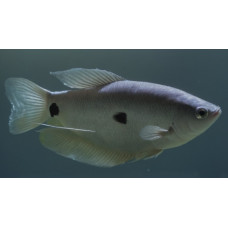Latin name
Trichopodus trichopterus
Other name
Opaline gourami, blue gourami, and gold gourami.
Identification
In terms of body shape and fin structure, the fish resembles the pearl gourami, but its body is somewhat shorter. Numerous colour morphs of gourami were obtained by crossing different species of Trichogaster with spotted gourami: blue, golden, pearlescent and others.
This species has a labyrinth organ, which is a system of blood-permeable plates located in the suprabranchial cavity. This additional respiratory system enables them to survive in environments with limited oxygen and poor water quality.
Features of fish fins
The dorsal fin of the female is rounded, whereas that of the male is elongated and pointed.
Fish colouring
Under normal conditions, the fish is silvery with a faint purple tint and is covered in sparsely visible, irregularly shaped, purplish-grey transverse stripes. There are two dark spots on each flank, one at the base of the tail and one in the middle of the body. These spots can sometimes be barely visible and can sometimes become darker. The fins and tail are almost transparent with pale orange spots scattered on them, and there is a reddish-yellow border on the anal fin.
During spawning season, the males and then the females undergo a dramatic change: the spots on their fins become brightly coloured, the whole fish darkens and the stripes on their bodies turn almost black. The eyes turn red and the lower fin becomes covered in bright orange spots with a rainbow-coloured border. The female is coloured almost the same as the male.
Distribution
It is widespread in the waters around the Malacca Peninsula, southern Vietnam and the large islands of Indonesia.
Habitat
They inhabit bodies of standing water and slow-flowing rivulets.
Size
In their natural habitat, these fish grow to 20 cm in length. In an aquarium, they reach 10–11 cm, rarely growing to 15 cm.
Behavior
When they are young, they get along well with other peaceful species of fish. However, they may become aggressive towards other fish in the aquarium as they grow older.
Food and feeding habits
In their natural habitat, these fish feed on small invertebrates such as the larvae and pupae of mosquitoes, midges and gnats, as well as crustaceans and other small aquatic organisms. They also consume algae and aquatic plants.
Reproduction
Gourami reach sexual maturity at around 6–8 months of age. The male embraces the female to help her release her eggs, which he then immediately fertilises. The eggs are picked up by the water current and rise to the surface, where the male places them in an air nest. This process may be repeated several times until all the eggs have been released.
Aquarium conditions
To avoid damaging the labyrinth organ, the aquarium should be kept in a room with an air temperature close to that of the water in the aquarium. The aquarium should have effective filtration and a gentle water flow. This species loves floating plants, but the entire surface of the aquarium should not be covered with them; the fish need access to the surface to ingest air. Water temperature: 26 °C. pH: 6.0–8.8. Hardness: 5–35 dGH.
| Classification | |
| Phylum | Chordata |
| Class | Actinopterygii |
| Squad | Anabantiformes |
| Family | Osphronemidae |
| Genus | Trichopodus |
| Species | T. trichopterus |
| Features | |
| Conservation status | Least Concern |
| Habitat | Pelagic |
| Life span, years | No information |
| Maximum body weight, kg | No information |
| Maximum length, cm | 20 |
| Sailing speed, m/s | No information |
| Threat to people | Not edible |
| Way of eating | Planktonophage |
Three spot gourami
Tags: three spot gourami



